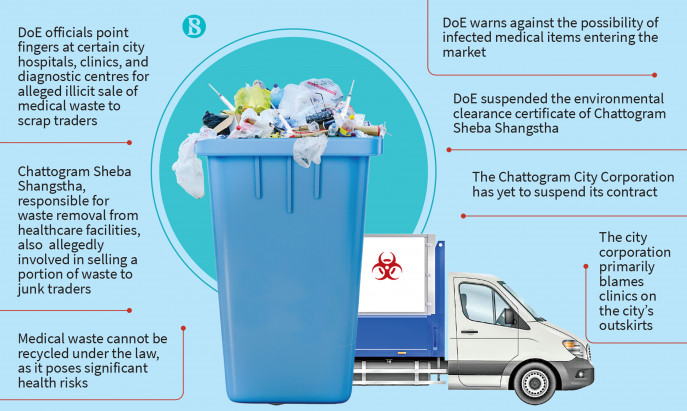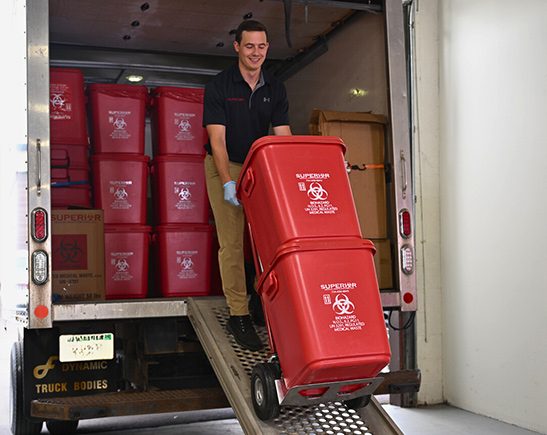Proactive Health And Wellness Solutions: Choosing the Best Medical Waste Removal Near You
Proactive Health And Wellness Solutions: Choosing the Best Medical Waste Removal Near You
Blog Article
Minimize Expenses and Maximize Safety: Effective Medical Waste Disposal Techniques
Effective clinical waste disposal methods are essential for healthcare centers to reduce prices and optimize safety. With the growing concern for ecological sustainability and the increasing variety of laws surrounding waste administration, it is vital for healthcare companies to embrace reliable and certified methods. By executing appropriate segregation and categorization, reliable packaging and labeling, safe transportation and handling, effective treatment and disposal approaches, and compliance with governing standards, healthcare centers can make certain the accountable and risk-free management of medical waste. In this discussion, we will discover each of these strategies carefully, giving understandings and functional suggestions for healthcare specialists to optimize their garbage disposal procedures.

Correct Segregation and Classification
Proper segregation and classification are critical parts of efficient clinical waste disposal strategies, guaranteeing the security of medical care employees, the general public, and the environment - medical waste removal service. medical waste disposal services with WasteX. By dividing various kinds of clinical waste at the factor of generation, health care facilities can decrease the threat of cross-contamination and potential injury to individuals and ecosystems
Among the crucial factors in proper partition is the recognition and classification of medical waste. This includes categorizing waste into various teams, such as transmittable, unsafe, contaminated, or pharmaceutical waste. Each group needs specific handling, storage, and disposal techniques to stop any negative impacts on human health and the atmosphere.
In addition, proper partition additionally includes the usage of color-coded containers and labels to plainly determine and set apart the various kinds of medical waste. This assists health care employees and waste monitoring personnel to quickly recognize and manage the waste suitably. Red containers may be made use of for infectious waste, while yellow containers might be designated for dangerous waste.
In addition to partition, proper classification additionally entails the appropriate product packaging and control of medical waste. This makes sure that waste is firmly stored and transferred without posturing any type of risks to people or the setting. Using leak-proof and puncture-resistant containers, as well as properly sealing and identifying them, aids to stop any type of unintentional direct exposure or release of harmful materials.
Effective Packaging and Classifying
Reliable product packaging and labeling play a vital duty in ensuring the safe and efficient disposal of clinical waste. Correct packaging is necessary to avoid leak, breakage, or spillage during transport and handling. It helps to reduce the threat of contamination and safeguards medical care workers, waste management employees, and the setting from prospective risks.
Medical waste should be packaged in leak-proof and sturdy containers that are immune to puncture and damage. These containers need to be properly secured to protect against any kind of leak. Furthermore, the packaging needs to have the ability to withstand the conditions of transportation, consisting of temperature level variations and rough handling.
Classifying is just as essential as it offers crucial details concerning the contents of the waste and any type of prospective risks related to it. The tags need to consist of the name of the healthcare center, the kind of waste, and any unique handling directions. Standard and clear labeling guarantees that waste management workers can easily recognize and deal with the waste appropriately.
Effective packaging and labeling likewise help in the proper partition and categorization of clinical waste. Clear labeling allows for very easy identification of different waste streams, such as contagious waste, sharps, or pharmaceutical waste. This helps in improving the disposal procedure and ensuring that the waste is dealt with or disposed of according to regulatory guidelines.
Safe Transportation and Handling
Ensuring the safe transportation and handling of clinical waste is of utmost value in order to prevent any possible health and wellness and environmental threats. Medical waste, such as sharps, polluted materials, and pharmaceutical waste, must be appropriately packaged and managed to lessen the risk of direct exposure to dangerous compounds and virus.
Transferring clinical waste calls for compliance with strict laws and guidelines established by ecological firms and regional authorities. These laws aim to safeguard the wellness and security of employees included in waste administration and prevent the release of unsafe products into the setting.
To make certain risk-free transport, medical waste should be put in puncture-resistant and watertight containers that are properly secured and classified. These containers must be safeguarded in a way that stops spills or damage during transit (medical waste removal services). Furthermore, it is crucial to use customized automobiles equipped with appropriate security functions to move clinical waste. These cars must have adequate air flow and be developed to stop leak or contamination.
Dealing with medical waste likewise calls for correct training and adherence to safety methods. Employees involved in the handling of clinical waste should use proper personal safety equipment (PPE) such as masks, handwear covers, and dress to decrease the threat of exposure. They need to also comply with strict health practices to avoid the spread of infections and make certain the secure disposal of waste.
Reliable Therapy and Disposal Methods
Applying appropriate therapy and disposal techniques is crucial in taking care of clinical waste properly and reducing potential health and wellness and environmental dangers. Medical waste, that includes sharps, infectious products, chemicals, and pharmaceuticals, can posture significant threats if not handled and taken care of appropriately. There are numerous therapy and disposal approaches readily available that abide by regulative standards and promote risk-free techniques.
One common approach is incineration, which includes shedding the waste at high temperature levels. Incineration is reliable in ruining virus and minimizing the quantity of view waste, yet it can release damaging contaminants into the air otherwise correctly regulated. As a result, it is necessary to make use of modern-day incinerators furnished with emission control Full Report modern technologies.
One more approach is autoclaving, which makes use of vapor and pressure to sterilize the waste. Autoclaving is reliable in killing virus and reducing the quantity of waste, but it calls for mindful surveillance and upkeep to ensure correct performance. The sanitized waste can then be safely gotten rid of in a land fill.
Chemical therapy is another choice, which involves using disinfectants or various other chemicals to counteract microorganisms. This approach is typically made use of for liquid waste, such as research laboratory samplings. Nevertheless, it is necessary to use ideal chemicals and follow appropriate procedures to make certain reliable treatment and avoid ecological contamination.

Compliance With Regulatory Guidelines
Following regulatory standards is important in ensuring appropriate conformity with clinical waste disposal practices. These guidelines are established to protect public health and wellness, protect against environmental contamination, and maintain work environment safety. Conformity with governing standards is important for healthcare facilities, as non-compliance can lead to fines, penalties, and reputational damages.
Governing standards describe the proper handling, storage space, transportation, and disposal of medical waste. They give particular directions on packaging needs, labeling, and record-keeping. These guidelines also deal with the segregation of different waste streams, such as sharps, infectious waste, and pharmaceutical waste. Healthcare centers have to ensure that their waste administration methods straighten with these guidelines to decrease the risk of direct exposure to harmful materials and protect against the spread of infections.
To keep compliance, healthcare centers should establish thorough waste monitoring programs that include staff training, normal audits, and continuous monitoring. It is vital to maintain updated with any kind of modifications or updates to regulatory guidelines, as methods might progress with time. By staying notified and applying appropriate procedures, health care facilities can decrease the possibility for governing infractions and safeguard the health and wellness of their personnel, individuals, and the surrounding area.
Final Thought
Finally, carrying out effective medical garbage disposal strategies is critical for minimizing prices and optimizing safety and security. Proper partition and classification, effective packaging and labeling, secure transport and handling, and effective treatment and disposal approaches are crucial actions to ensure compliance with governing guidelines. medical waste removal near me. By adhering to these strategies, health care centers can protect the environment and public health and wellness while also decreasing economic worries associated with medical waste monitoring
By applying correct partition and categorization, reliable product packaging and labeling, safe transport and handling, effective treatment medical waste disposal services with WasteX and disposal approaches, and compliance with governing guidelines, healthcare centers can make sure the secure and accountable monitoring of medical waste. Red containers might be made use of for transmittable waste, while yellow containers might be assigned for hazardous waste.
Standard and clear labeling guarantees that waste management employees can easily recognize and handle the waste properly. (medical waste disposal services with WasteX)
Clear labeling enables for simple recognition of various waste streams, such as transmittable waste, sharps, or pharmaceutical waste. These standards additionally resolve the partition of different waste streams, such as sharps, infectious waste, and pharmaceutical waste.
Report this page